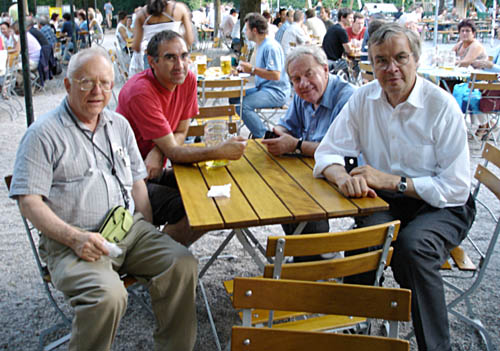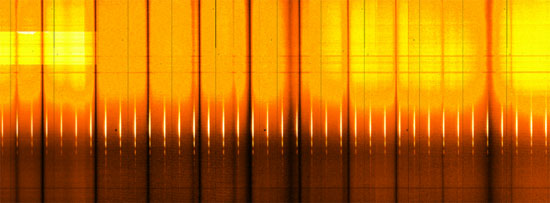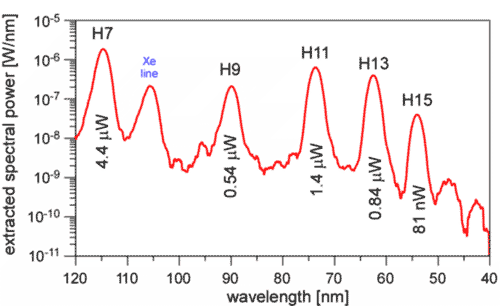
High Precision Measurements for fundamental Physics

 |
High Precision Measurements for fundamental Physics |
 |
Welcome to the Frequency Comb projectWe are part of the group of Prof. T. W. Hänsch and located at the Max-Planck Institute for Quantum Optics Garching/Germany.  Physik Nobelpreis 2005 für die optische Frequenzkammtechnologie. Hier ist in einfachen Worten erklärt was ein Frequenzkamm ist und wofür er gebraucht wird. 
Zwei
der frisch der Physik Nobelpreisträger von 2005 John Hall und Theodor
Hänsch
(vorne links und rechts) zusammen mit Kollegen Thomas Udem und Ronald Drever (hinten links und rechts) in einem Münchner Biergarten im Sommer 2005.
Frequency combs to measure Cosmic Velocities
High
resolution laser spectroscopy advanced a significant step forward when
frequency combs were introduced to directly measure the frequency of
the laser light that is used to excite atoms, ions or molecules. A
prerequisite for this approach seems to be the coherence of the light
source whose frequency is measured. On the other hand, there is a class
of incoherent light sources that are scientifically interesting, but
cannot be measured with coherent lasers. The most prominent of these
light sources are astronomical objects like stars, galaxies and
quasars. One of the possible exciting measurements is to determine the
velocities of these objects from the Doppler shifts that their motion
relative to the earth imposes on their spectra.
Spectrographs connected to telescopes have been used for that purpose, and they were typically calibrated against argon-thorium lamps or iodine absorption cells. The new generation of spectrographs, however, are limited in reproducibility by these calibration methods, because systematic shifts make it difficult to compare data recorded with different instruments. In addition, the lines of Th-Ar lamps are sparse so that non-linearities of the calibration curve of the spectrograph cannot be determined with high confidence. For this reason, we are now using a frequency comb that is directly stabilized to an atomic clock. The frequency comb possesses a dense grid of calibration lines that we can adjust to have a separation just above the resolution limit of the spectrograph.  The figure shows a section of the spectrum
of the Sun around 189.3THz (1584nm). Visible in dark are Fraunhofer absorption
lines of gaseous elements in the photosphere of the sun and as bright shorter
vertical lines the calibration lines of the frequency comb. Astronomers measure Doppler shifts as well
as optical detunings in terms of the corresponding velocities. While the state
of the art in instrument calibration is around 10m/sec (v/c=3e-8), we believe
that 1cm/sec can be reached within the next years using frequency comb
calibration. With this type of uncertainty, several intriguing observations
will become possible. One of them is the detection of earth-like extra-solar
planets orbiting sun-like stars from the recoil motion of the star. The
required velocity resolution for the earth-sun system is 10cm/sec. In addition,
when monitoring the cosmic red shift for a few years, it will be possible to
decide whether the expansion of the universe is accelerating. This cosmic
acceleration has been predicted from the pattern of the cosmic microwave
background assuming the validity of general relativity. Such a direct
observation could be decisive on whether or not dark energy, together with
general relativity, constitute the proper model, or if we have to seek out for
new explanations. Tilo Steinmetz et al. Science 321, 1335 (2008) A press release with explanations for the non-physicist, graphs and animations
is found here in English and German Frequency combs in the Extreme Ultraviolet (XUV)
by intracavity High Harmonic Generation (HHG) Femtosecond
laser optical frequency combs have revolutionized the measurement of
optical frequencies and enabled optical atomic clocks. The same comb
techniques are employed to control the carrier-envelope phase and thus
the waveform of ultrafast laser pulses, which has led to the generation
of single attosecond pulses. We hope that intracavity high harmonic
generation (HHG) will open the door to another promising joint frontier
of precision spectroscopy and ultrafast science. We are generating
coherent radiation in the extreme ultraviolet (XUV) by high harmonic
generation at the full oscillator repetition frequency of 10-100 MHz
which is up to a 1000 times faster than previously possible with
chirped pulse amplification or regenerative amplifiers. This high
repetition rate causes the modes of the resulting XUV frequency comb to
be well separated, allowing high resolution laser spectroscopy in this
spectral region for the first time. Simultaneously, this method makes
it possible to cover the full electromagnetic spectrum from infrared to
soft X-rays with sharp and selectable continuous laser modes using the
same set-up.
 We couple
the pulses from a femtosecond Kerr-lense mode-locked laser into a high
finesse optical resonator that contains a Xenon gas jet at the cavity
focus as the nonlinear medium. Inside this resonator, the pulse energy
is enhanced by a factor of 100 so that it can drive the nonlinear
process (HHG). For cw lasers, enhancement factors exceeding 100,000
have been reached and overall nonlinear conversion efficiencies
approaching unity can be achieved. In the case of a mode-locked
ultrafast laser, however, complying with the following extra
requirements is more difficult: The output spectrum of a mode-locked
laser does not contain just a single cw mode but a comb of such modes.
An optical resonator for such radiation has to be simultaneously
resonant for each mode. This can be accomplished with a resonator of
appropriate length and zero group velocity dispersion (GVD). As shown
below, we have managed to extract microWatts of XUV power which should
be sufficient to drive the 1S-2S transition in a hydrogen-like Helium
ion with a reasonable rate (~1 Hz) provided that this power can be
delivered and focussed onto the ion.
 While we were able to generate high harmonics with a mode spacing of 110MHz in 2005, the total generated power was far from being useful for high resolution spectroscopy, say, at the sharp 1S-2S transition in hydrogen-like He at 60.8nm. In the meantime, we have improved our system considerably and reduced the repetition rate to 10MHz. This mode spacing will still be sufficient to resolve individual modes with a sharp resonance, but allows for a 10 times higher pulse energy. Thanks to the highly non-linear character of HHG, this modified setup produced uW power levels for each harmonic as shown above. In principle this is sufficient to achieve a Hz type Rabi frequency for the 1S-2S transition in hydrogen-like He which is a typical value for a high precision single ion experiment. However, it remains to be shown whether we can actually deliver this power with a reasonable focus size to the ion. If you want to read more about our work on intracavity high harmonics please see the following references: Christoph Gohle et al. Nature 436, 234 (2005) Akira Ozawa et al. PRL 100, 253901 (2008) last change September 18 2008 |